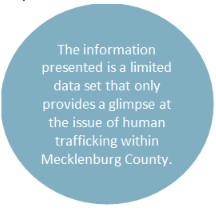
Hannah Arrowood
Founder & Executive Director | Present Age Ministries
Board of Directors, Vice Chair | Charlotte Metro Human Trafficking Task Force
Board of Directors, Chair | Present Age Kenya
Board of Directors, Member | SWAT International, Thailand
© 2023 Present Age Ministries
Present Age Ministries
PO Box 700
Harrisburg, NC 28075
Phone: 704-956-2120
www.presentageministries.org
Recommended Report Citation
Present Age Ministries (2023). Exploitation in the Queen City: An Examination of Human Trafficking of Minors. Charlotte, NC: Present Age Ministries.
Mecklenburg 2023
Human Trafficking Minors Report
EXPLOITATION IN THE QUEEN CITY
An Examination of Human Trafficking of Minors
ACKNOWLEDGEMENTS

CHARLOTTE METRO HUMAN TRAFFICKING
- Atrium Health – Human Trafficking Unit
- Charlotte Mecklenburg Police Department – Human Trafficking Unit
- Mecklenburg County Department of Social Services – Youth and Family Services
- Pat’s Place Child Advocacy Center
- Present Age Ministries
Second, we would like to thank the partner agencies within the community that screen youth for commercial sexual exploitation. In addition to the agencies listed above, this includes:
Council for Children’s Rights
Guardian Ad Litem
Teen Health Connection
Finally, we would like to thank all those dedicated to identifying and responding to the crime and impact that child sexual exploitation poses to our community. The efforts of dedicated individuals at each agency provides a safety net that is invaluable to our vulnerable youth.
INTRODUCTION
In the words of W. Edwards Deming, “Without data, you are just another person with an opinion.” The safety and protection of children is of the upmost importance to the stability of any community. Having data to explain patterns, trends, and irregularities within our communities is a vital element to the trajectory and planning of the future we hope to secure. Our systems and processes must ensure that the vulnerable are not inadvertently being overlooked. We must be committed to evaluating and improving these systems and processes when we recognize that our children’s safety has been jeopardized. We simply cannot accept less.
Human trafficking, or the exploitation of people for labor services or commercial sex acts, is a criminal enterprise and a human rights violation. Even with the passing of the Trafficking Victims Protection Act (TVPA) in 2000, reliable and timely data about cases of trafficking in the United States is still difficult to solidify due to the lack of cross-communication among stakeholders and the ability to share data. It is time we dedicate specific resources, funding, and focused attention to this matter.
For the purposes of this report, the definition of human trafficking is that provided by the
Trafficking Victims Protection Act (2000), which defines several forms of human trafficking as follows:
Sex trafficking (i.e., the recruitment, harboring, transportation, provision, or obtaining of a person for the purpose a commercial sex act) in which a commercial sex act is induced by force, fraud, or coercion.
Or in which the person induced to perform such act has not attained 18 years of age; or
The recruitment, harboring, transportation, provision, or obtaining of a person for labor or services, by force, fraud, or coercion for the purpose of subjection to involuntary servitude, peonage, debt bondage, or slavery.
This report evaluates a 36-month time-period from January 2020 to December 2022, analyzing the impact of Commercial Sexual Exploitation of Children (CSEC) within Mecklenburg County. According to The Office of Juvenile and Delinquency Prevention, the definition of CSEC is a range of crimes and activities involving the sexual abuse or exploitation of a child for the financial benefit of any person or in exchange for anything of value (including monetary and non-monetary benefits) given or received by any person (Sexual Exploitation of Children, 2022). We will analyze victimization status, gender identification, engagement with law enforcement, age at time of referral, and geographical locations.
To ensure an understanding of the data presented within this report, here are the most common myths and stereotypes to review before reviewing the data:
Most trafficking victims in the U.S. are undocumented foreign nationals. The majority of cases across the U.S. and within Mecklenburg County are domestic cases of trafficking.
Trafficking only happens in certain areas. CSEC is identified in every state and major city across the U.S., including Charlotte and its greater metropolitan area – the state’s #1 documented city for trafficking. Factors that increase exposure in the Charlotte area include major interstate highways, large events that draw people to the city, an international airport, and highly populated venues such as malls and sporting events.
Child victims of sex trafficking understand that what has happened to them is wrong and clearly understand they are a victim of a crime. In other forms of sexual abuse or assault there is often a clear perpetrator and a clear victim. With cases of trafficking there are often complexities that are difficult to understand at first glance. Trauma bonding, PTSD, and increased vulnerabilities contribute to dissociation and lack of self-identification.
Appropriate identification is equivalent to the prevalence of an issue. Minor victims of trafficking rarely, if ever, self-identify. Therefore, it requires training and implementation of screening tools and protocols at the community level to interrupt and intersect victimization. There was a 62% increase in persons referred to U.S. Attorneys for Human Trafficking when comparing data from 2011 to 2020 across the country. (Human Trafficking Data Collection Activities, 2022).
Most people think of “trafficking” as involving movement across state or international borders. 18 U.S.C., Section 1591 does not require proof that either the defendant or victim crossed state or international lines (Citizen’s Guide to U.S. Federal Law on Child Sex Trafficking, 2020). Within Mecklenburg County, we rarely see kidnapping as the means of force. Grooming and strategic manipulation is a much more common method used by traffickers to ensure compliance.
Those involved in prostitution, even a teenager, choose that lifestyle. A commercial sex act (often referred to as prostitution) is sexual activity in exchange for something of value. Any commercial sex act involving a minor is considered sex trafficking or commercial sexual exploitation of children, according to TVPA. Another way to say this is a minor cannot consent to commercial sex; therefore, there is no such thing as a child prostitute.
DEFINITIONS OF TERMS
Confirmed – A child noted as a confirmed victim of trafficking refers to the ability to prove the crime of sex trafficking of a minor through evidence, witness testimony, or other elements of the law. This status of victimization is not linked to prosecution.
Evaluation – Refers to a clinical assessment performed by a licensed professional due to red flags presented; usually taking place within a hospital medical system such as Atrium or Novant.
Identified/Identification – Identification of a minor victim refers to the screenings, assessments, interviews, or evaluations conducted by the agencies named in this report; based on training and expertise in this field.
Minor – Refers to a child who, at the age of identification, has not yet reached eighteen years of age.
Partner Agency – A community agency, vetted by the Charlotte Metro Human Trafficking Task Force, in adherence to the NC Standards of Care.
Recovery – A law enforcement operation to recover a child who is suspected to be involved in trafficking. Information provided to law enforcement can come from a variety of methods such as missing persons reports, report of online ads, and other means.
Screening Assessment – An evidence-based screening tool used by all partner agencies that proactively identify concern for human trafficking. The evidence-based screening tool identified and implemented in 2018 is the West-Coast Screening Tool called CSE-IT.
Self-Identify – A child’s ability to recognize and articulate to adults that the activity in which they are engaged in is wrong, criminal, and harmful.
Suspected – A child noted as a suspected victim of trafficking refers to the inability to prove that the crime of sex trafficking of a minor due to lack of evidence, witness testimony, or other elements that would meet the standard of the law; however, the professionals involved in the case are confident of the victimization based on presented factors.
Victim – Refers to a child; 17 years or younger; identified as the one impacted by the crime and abuse of trafficking, as defined by TVPA.
DATA COLLECTION
According to THORN, a key piece in developing innovative approaches to combat child sex trafficking is to gather quantitative and qualitative data from trafficking survivors. We must understand the ways in which traffickers are leveraging networks and platforms to recruit, groom, and sell child sex trafficking victims (Child Sex Trafficking Statistics, 2022). In 2018, a report was issued by Pat’s Place Child Advocacy Center that reviewed the issue of exploitation and trafficking within Mecklenburg County. Since then, there has not been further research or data presented in the country. In 2020, North Carolina ranked ninth in the country for the volume of calls regarding human trafficking cases reported to the National Human Trafficking Hotline (Polaris, 2020).
Up to this point there has not been a systematic approach to collecting data, and we set out to change that and establish a consistent and reliable way to retrieve data. Reliable, valid, and ongoing data around the issue of human trafficking is needed for us to develop, implement, and maintain prevention programs and victim support services. Furthermore, to fund these programs, we must understand the needs, capacity, gaps, and collaborative opportunities that exist within the current community framework. Data collection is necessary and a best practice within any network. According to the Child Welfare Information Gateway, collecting and analyzing data to measure and verify the effectiveness of services rendered helps organizations make informed policy and practice decisions toward improving outcomes for children and families (Preventing Violence Together, 2022).
Community Data Around Child Sexual Exploitation of Children (CSEC)
Present Age Ministries is a trusted service provider in the Charlotte Region committed to combatting the sexual abuse, exploitation, and trafficking of teen girls. With over ten years of experience serving victims of CSEC, they provide integrated support services to identified minor victims of trafficking. They maintain long-term relationships with identified clients and families, which provides ongoing evaluation of services, gaps, and needs of clients. Furthermore, Present Age has chaired the Education & Training Committee for the Charlotte Metro Human Trafficking Task Force for the past five years, working with agencies across the city to evaluate and implement training to professionals.
As a member of a Multi-Disciplinary Team (MDT) established to respond to potential cases of trafficking of minors, Present Age invited these child serving agencies to participate in data collection. The agencies involved in this project included those that have received specialized training around the issue of human trafficking and have active teams within their respective agencies that specialize in cases of human trafficking.
A unique identifier formula shared among all participating agencies was used to identify and remove duplicative entries and track referrals between agencies. In the years to come, we have strategic plans to evaluate repeat cases, year after year, and determine breakdowns in the system referrals, gaps in services, and other factors.
GENERAL RESULTS AND FINDINGS
Abuse is the physical, sexual, or emotional maltreatment of a child. Abuse and neglect also include human trafficking. North Carolina law requires any adult to report suspected child maltreatment. Proof of maltreatment is not necessary for reporting; you only need reasonable cause to suspect maltreatment. Further, you do not need anyone’s permission to file a report. Therefore, any minor child who is a suspected victim of human trafficking should also be reported (About Child Abuse and Child Neglect).
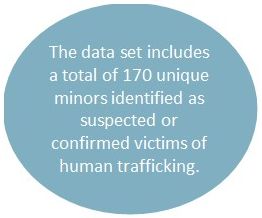
Traffickers are highly skilled and adept at identifying people with noticeable vulnerabilities or needs. They may scour specific locations such as bus stations, shelters, or local malls looking for someone without a safe place to stay, or someone whom they may be able to charm with their flattery and attention (Polaris (b) 2021). It is important to understand cultural norms within communities and to identify individuals that traffickers would target as lacking dedicated support networks.
There were fifty or more unique cases of CSEC minors identified each year, combining for 170 unique cases. Duplicative cases were removed for data reporting accuracy. There were only two cases in the data set that required immigration services: only 1.2 % of all reported cases.
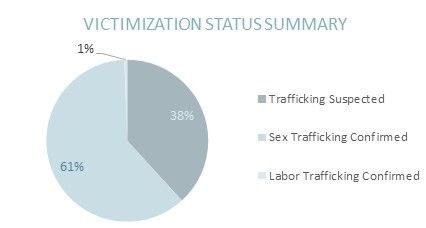
- 61% of identified cases presented as confirmed cases of sex trafficking
- 38% of the cases presented as suspected cases of sex trafficking
- Less than 1% of the cases presented as confirmed labor trafficking.
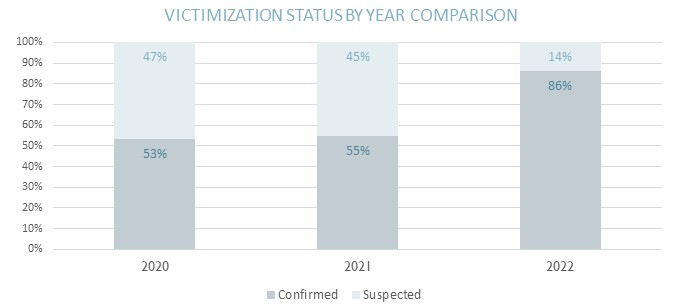
When comparing the rate of suspected cases identified versus confirmed cases identified, it is encouraging to see that the rate of confirmed cases increased with each year. This is a result of increased training efforts and specializing units within each agency. Furthermore, it is evidence of the impact of having a Multi-Disciplinary Team response. Having dedicated people, resources, and a community response increases the rate of positive identification.
The investigation of human trafficking cases is complex in nature. Mecklenburg County has limited resources and workforce dedicated to this issue. As mentioned in myths and stereotypes, CSEC victims rarely, if ever, self-identify. The numbers represented in this data set (170 unique cases) represent only a percentage of those being trafficked within Mecklenburg County. These identifications are based on the training and response of professionals who had the ability to recognize and respond to what they believed was a CSEC victim.
AGE RESULTS AND FINDINGS
Data that proves to be beneficial and useful will always analyze the age of victimization. Based on the Trafficking Victims Protective Act, any commercial sex act with a minor (17 years old or younger) is to be considered human trafficking. One often debated factor is the statute defining the age of consent in North Carolina, which refers to the age at which a person can consent to consensual sex. With that in mind, the age of consent in North Carolina is 16 years old. That means that for 64% of victims (15 years or younger), they should automatically be considered a victim and the burden of proof should be eliminated. Community programs and response protocols must be guided by the reality of the onset of victimization.
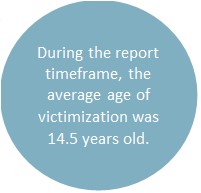
Furthermore, reports show that 70-90% of trafficking victims have a history of child sexual abuse. According to The National Child Traumatic Stress Network, “research has repeatedly shown that child sexual abuse can have a profoundly serious impact on physical and mental health, as well as later sexual adjustment. Depending on the severity of and number of traumas experienced, child sexual abuse can have wide-reaching and long-lasting effects. Those who have suffered multiple traumas and received little parental support may develop post-traumatic stress disorder, depression, and anxiety. Their ability to trust adults to take care of them may also be jeopardized. Sadly, when children do not disclose sexual abuse and/or do not receive effective counseling, they can suffer difficulties long into the future” (Peterson, 2018).
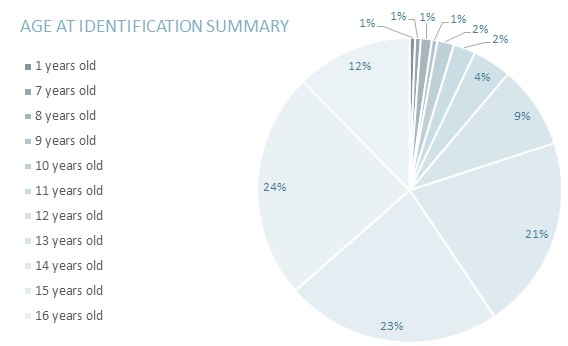
HIGH-LEVEL OVERVIEW:
64% of the minors identified were 15 years old or younger
36% of the minors identified were 16 or 17 years old
- 52% of the minors identified were 13-15 years old
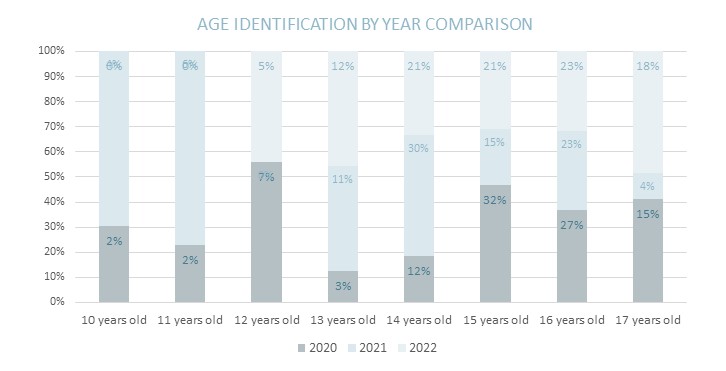
In the current data set, there is consistently 13–17-year-old minors identified, year after year. Minors aged 10 and 11 were identified in two of the three years evaluated in the report. The outliers are the children aged nine and younger. These cases are increasingly more difficult to evaluate and investigate due to the developmental stages of the victim and verbal abilities to articulate and describe the abuse. Each year there is a significant increase in the number of 15-, 16- and 17-year-old minors identified. We have theories as to reasoning behind this, but it will take years to validate.
GENDER RESULTS AND FINDINGS
The ratio of victimization between males, females, and those identifying as transgender has long been a topic of debate. Understanding the gender of victims allows services to be specialized and individualized. In a 2011 report by the Bureau of Justice Statistics, on the characteristics of suspected human trafficking incidents, almost 95 percent of sex trafficked victims were female. We see this trend demonstrated within Mecklenburg County with 98% of the data set presented identified as females.
In the data set presented, a small percentage of victims identified were either male or identified as transgender. Reduced rates of identification among males or transgender victims can be misleading. Proportionally there is also a reduced rate of identification on all sexual traumas among these populations. Based on what we know regarding victim’s low rate of self-identification and societal norms, we are sure there are higher rates of victimization and will work to find community solutions in this area. Research reveals that human trafficking among LGBTQ individuals is underreported due to the stigma of same-sex relationships and because societal barriers may prevent males from disclosing (Martinez & Kelle, 2013).
HIGH-LEVEL OVERVIEW:
98% of the identified minors were female
1% of the identified minors were male
1% of the identified minors were transgender
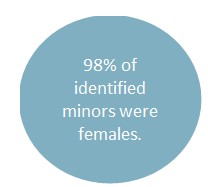
LAW ENFORCEMENT RESULTS AND FINDINGS
Often it is believed that “bad kids,” or “delinquents” get caught up in this lifestyle because of their choices. You will see that for most cases, that is not the case. Out of the 170 unique minors identified as suspected or confirmed victims of human trafficking, we had detailed information regarding interaction with law enforcement for 112 of those cases. Understanding interaction with law enforcement, outside of victimization, is imperative to learning about the behaviors and vulnerabilities.
Meeting basic physical and emotional needs is a method of recruitment commonly used by traffickers. CSEC victims can find themselves involved in criminal activities as a form of survival, or in response to the trauma to which they were exposed. We know that homeless youth spend more time in public spaces, making them vulnerable and exposed to being preyed upon by traffickers (Pfenning, Elizabeth, et al (2103).
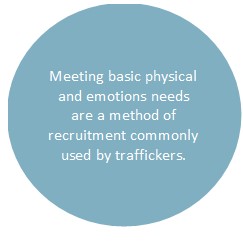
There are factors that can influence the rate of criminalization of minors who are consequently also a victim of child sexual exploitation. One primary reason is the absence of identification by the victim. This leaves the burden of identification to the officers, social workers, or court counselors that encounter the juvenile. While training protocols have improved over the last decade, we still have high turnover rates within these professionals making ongoing training difficult.
Research shows that barriers to treating juveniles involved in commercial sex as victims rather than perpetrators include, among other things, a lack of knowledge and victim identification by law enforcement and other officials as well as a lack of secure facilities where these minors can receive appropriate shelter and specialized services (Finklea, 2014).
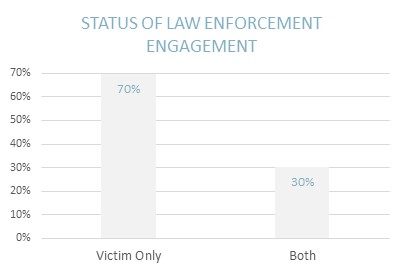
HIGH-LEVEL OVERVIEW:
70% of cases were CSEC Victim Only (no other criminal activity associated)
30% of cases included CSEC identification as well as other criminal charges
GEOGRAPHICAL FINDINGS
Throughout communities, there is often a narrative that trafficking involves kidnapping and only impacts certain demographics. You will see with overwhelming confirmation that those theories are inaccurate. The data set contained within this report allows us to review the zip code location of the child residence, not necessarily the location of the suspected or confirmed trafficking occurrences.
The National Center for Missing and Exploited Children states that “while any child can be targeted by a trafficker, research, data, and survivor lived experience and expertise have revealed traffickers and buyers often target youth who lack strong support networks, have experienced violence in the past, are experiencing homelessness, or are marginalized by society” (Child Sex Trafficking). We know that layered vulnerabilities (lack of dedicated support systems, history of abuse, homelessness, and other risk factors) increase the probability of victimization, which may or may not be related to a child’s specific location of residence.

*Highlighted areas show confirmed cases; Square Markers show suspected cases.
HIGH-LEVEL OVERVIEW:
- Forty zip codes had CSEC cases associated
- Twelve zip codes had both suspected and confirmed cases of trafficking
- The five zip codes with the highest impact where: 28269, 28208, 28213, 28216, and 28212.

RECOMMENDATIONS
Sexually exploited children suffer from physical and psychological health issues stemming from a variety of factors such as living conditions, workplace conditions, access to basic needs, and general lack of quality health care (Resources, 2011). Victims of trafficking can face sexually transmitted diseases, unwanted pregnancies, and challenging or life-threatening medical conditions. In addition to the physical challenges presented during and after abuse at the hands of their traffickers, victims often suffer from a variety of mental health issues.
CSEC victims often suffer extreme shame about their experiences, and they may face the stigma associated with being “sexually promiscuous” (Walker N.d.). Sexually exploited persons suffer from high rates of post-traumatic stress disorder (PTSD), Stockholm Syndrome, memory loss, aggression, fear, depression, anxiety, hostility, anger issues, sexually transmitted disease/infection (STD/STI), physical trauma from beatings, and emotional and psychological trauma from engaging in unwanted sex (Greenbaum 2014; Cohen, Edberg, and Gies 2011; Raymond and Hughes 2001).
COMMUNITY EDUCATION
Identifying areas impacted as well as geographical hot spots will enable us to fuel community education programs that are specific to the unique realities present within each community. Further research on data elements within those specific communities will allow us to understand the unique risk factors within those specific areas. Collaboration strategies are community based and not reliant on one single agency.
During 2023, the Charlotte Metro Human Trafficking Task Force, in partnership with Mecklenburg County Parks & Recreation Centers, will be presenting community engagement conversations within the identified zip codes that presented the highest rates of trafficking to initiate education around the topic of sex trafficking.
STRENGTHENING PREVENTION PROGRAMS
Prevention strategies need to link to adolescent development to ensure effectiveness. Knowing the age of onset of victimization is critical to accomplish this. Considering the research that shows victimization could be ongoing for two-years before identification in correlation with the average age of victimization within Mecklenburg County is 14.5 years old, prevention should begin before Middle School. North Carolina Senate Bill 279 states that education on human trafficking should take place in 7th and 8th grade Health Classes. Confirming implementation of this requirement as well as reviewing the content and method of delivery is recommended. Furthermore, child abuse prevention curriculum must be reviewed and implemented in elementary schools to ensure that children are educated to diminish the impacts of early childhood trauma.
Empowering and enhancing mentorship programs is a viable option to reduce vulnerabilities in youth. Historically, prevention and intervention methods have been used to address youth with “red-flags” or risk-taking behaviors.” The efforts of these programs aim to address behaviors and deterring youth from continuing to engage in the behaviors that put them “at-risk” for harm to self, others, and entering deeper levels of dysfunction or detriment to physical and mental health and well-being. Research identifies that active, focused, skill-based lessons, focused on causal and risk factors identified by research, with adequate dosage are key. (Jones, L.M., Mitchell, Kimberly J., & Walsh, W.A. 2014). In addition, mentoring programs are a prominent strategy in the United States for preventing negative outcomes and promoting resilience among at-risk youth (DuBois, 2021).
TRAINING FOR PROFESSIONALS
Training around victim identification is necessary and should be reoccurring for all professions that interact with children on a regular basis. Furthermore, this type of training should include case studies to apply skills to practical scenarios. Any agency that works with at-risk youth or vulnerable families should adopt training specific to victim identifications. Agencies that would benefit from ongoing training include and are not limited to: Department of Youth & Family Services, Department of Juvenile Justice, Guardian Ad Litem, Law Enforcement agencies, Juvenile Detention Centers, School Systems staff, Day Care/After School Programs, DV Shelters, Health Care Systems targeted at Emergency Departments and Primary Care Physicians in Pediatric Care, and all mentoring programs and intervention programs.
SCREENING & SERVICE EXPANSION
Understanding how children are interacting with the system of care within a community helps identify strengths and gaps. Digging into the history of identified victims as well as interagency protocols allows us to evaluate, adapt, and better serve. A collaborative screening solution was identified and implemented by six community agencies: Pat’s Place Child Advocacy, Youth and Family Services, Guardian Ad Litem, Present Age Ministries, and Teen Health. This training for the evidence-based screening tool: CSE-IT needs to be expanded within current agencies and implemented across other community agencies. This would allow for an increase in scope and response.
Regarding services to minor victims of trafficking, Present Age Ministries has historically been the only vetted service provider associated with of the Charlotte Metro Human Trafficking Task Force that is solely dedicated to individualized, long-term support services for minors. Data analysis provides greater understanding of demand and capacity needs.
There are gaps in services specifically offered for male victims. While the current data set does not support a demand for these services, we recognize that underreporting has the potential to skew this data and present a gap. Regarding foreign nationals, the A21 Campaign, a vetted service provider with the Charlotte Metro Human Trafficking Task Force, provides excellent case management and services catered to our foreign national population. When minor victims require these unique and specialized services, A21 is a collaborative partner.
CONCLUSION
The purpose of this report and data collection project was to gain greater understanding around the issue of commercial sexual exploitation of children within Mecklenburg County. Upon analysis there are recommendations that would reduce the risk and vulnerability to human trafficking in addition to addressing the needs of victims. Continued analysis and collaboration will enhance our understanding as well and identify gaps. Ongoing research will enhance prevention programs, inform intervention, and influence legislation. Increasing agency participation will also expand our scope.
